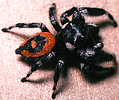dr_wu002
Well-known member
Anyone that has ever hiked above Treeline in the Presidentials during the summer months will know what I'm talking about: Little, black spiders... they're all over the place and really fast. I don't think they spin webs. I saw literally hundreds of millions of them over the weekend (Jefferson, Adams, Madison via. Great Gulf, Six Husbands, Gulfside, Osgood Ridge -- this will serve as the trip report: great weather, Six Husbands was fun and easy, Osgood Ridge Trail goes on forever. Pictures: http://community.webshots.com/album/374482318EiZoBp) but I just wasn't in the mood to try and photograph one of those buggers. They run away so fast I'm not sure that I'm quick enough.
Can anyone identify what kind of spider this is and does it only live above treeline? I've never seen this type of spider before below the tree canopy although maybe it's a coincidence. Does anybody have a close-up picture? I'm interested because I see so many of these things on the Rock Pile but I never see enough bugs that I believe to sustain the spider population. I know they are not vegetarians and they don't eat hikers so what is their food supply? I oftentimes wonder just what lives below all the rocks up there. Any info?
-Dr. Wu
Can anyone identify what kind of spider this is and does it only live above treeline? I've never seen this type of spider before below the tree canopy although maybe it's a coincidence. Does anybody have a close-up picture? I'm interested because I see so many of these things on the Rock Pile but I never see enough bugs that I believe to sustain the spider population. I know they are not vegetarians and they don't eat hikers so what is their food supply? I oftentimes wonder just what lives below all the rocks up there. Any info?
-Dr. Wu

